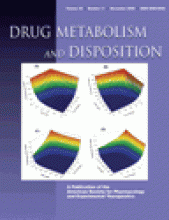Abstract
Liquiritigenin [2,3-dihydro-7-hydroxy-2-(4-hydroxyphenyl)-(S)-4H-1-benzopyran-4-one] is one of the major active compounds of MF101, an herbal extract currently in clinical trials for the treatment of hot flashes and night sweats in postmenopausal women. MF101 is a selective estrogen receptor β agonist but does not activate the estrogen receptor α. Incubation with pooled human liver microsomes yielded a single metabolite. Its structure was elucidated using tandem mass spectrometry in combination with analysis of the fragmentation patterns. The metabolite resulted from the loss of two hydrogens and rearrangement to the stable 7,4′-dihydroxyflavone. The structure was also confirmed by comparison with authentic standard material. Maximum apparent reaction velocity (Vmax) and Michaelis-Menten constant (Km) for the formation of 7,4′-dihydroxyflavone were 32.5 nmol/g protein/min and 128 μM, respectively. After correction for protein binding (free fraction = 0.84), the apparent intrinsic clearance (CLint) for 7,4′-dihydroxyflavone formation was 0.3 ml/g/min. Liquiritigenin was almost exclusively metabolized by CYP3A enzymes. Comparison of liquiritigenin metabolism in human liver microsomes isolated from 16 individuals showed 9.5-fold variability in metabolite formation (3.4-32.2 nmol/g protein/min). An estrogen receptor luciferase assay indicated that the metabolite was a 3-fold more potent activator of the estrogen receptor β than the parent compound and did not activate the estrogen receptor α.
Footnotes
-
doi:10.1124/dmd.108.021402.
-
ABBREVIATIONS: liquiritigenin, 2,3-dihydro-7-hydroxy-2-(4-hydroxyphenyl)-(S)-4H-1-benzopyran-4-one; HPLC, high-performance liquid chromatography; LC, liquid chromatography; MS, mass spectrometry; LLOQ, lower limit of quantitation; MS/MS, tandem mass spectrometry; Fu, fraction of unbound substrate; CLint, intrinsic clearance.
- Received March 7, 2008.
- Accepted July 29, 2008.
- The American Society for Pharmacology and Experimental Therapeutics
DMD articles become freely available 12 months after publication, and remain freely available for 5 years.Non-open access articles that fall outside this five year window are available only to institutional subscribers and current ASPET members, or through the article purchase feature at the bottom of the page.
|






